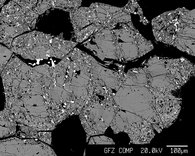Geochemical and Mineralogical Study of the Steenkampskraal Monazite Ore Body, Namaqualand, South Africa
The Steenkampskraal monazite [(Ce,La,Nd)PO4] ore body, Namaqualand, South Africa represents a little-known (if not previously unknown) style of REE mineralization, and is one of the richest REE deposits so far discovered worldwide. It consists of a massive lode-type, (REE+Th)-rich phosphate ore body in which Th-enriched monazite is the dominant mineral phase.
The current project involves a detailed geochemical and mineralogical investigation of the ore body and surrounding country rocks. A better understanding of the geochemistry and mineralogy of the ore body and surrounding rocks is critically necessary to assess whether the ore minerals developed as a highly evolved, hydrosaline magma originating from a more massive magma body deeper in the Earth’s crust or were deposited by brine-rich fluids which acted to transport and concentrate the Th, REE, and P from a more widely dispersed source. Such an understanding will assist in predicting occurrences of similar REE+Th, mineralized ore bodies elsewhere both in the general vicinity of Steenkampskraal and worldwide. The results from this study will also have far reaching implications with regard to the formation of REE-enriched iron oxide-phosphate deposits in general including iron-oxide apatite (IOA) deposits.
Fig.: This figure represents a high contrast, backscattered, scanning electron image of monazite from the Steenkampskraal ore body. The monazite has been partially metasomatically altered by fluids resulting in the depletion of Th and the formation of huttonite (ThSiO4) inclusions in the altered areas along with an obvious porosity, which allowed for fluid infiltration via a coupled dissolution-reprecipitation process


